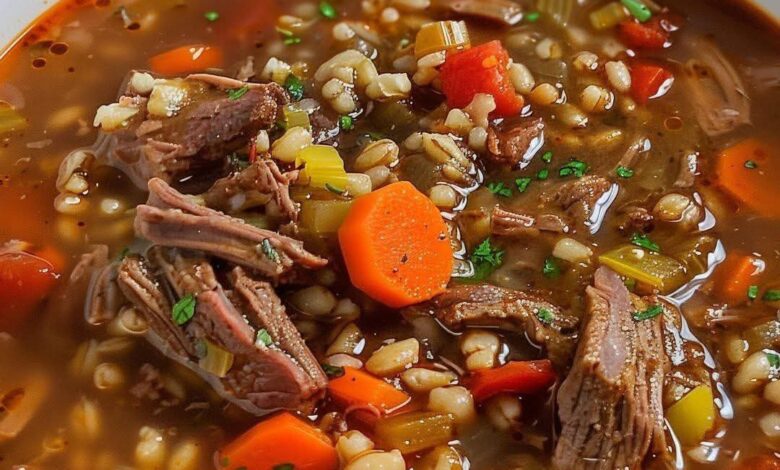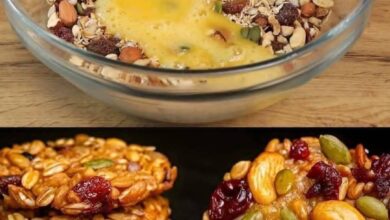Beef and Barley Soup

Of course! Here is a comprehensive, “big” recipe for Beef and Barley Soup, complete with all the sections you’ve requested.
Introduction
There are soups that merely satisfy hunger, and then there are soups that nourish the soul. Beef and Barley Soup firmly belongs to the latter category. This is not a delicate broth but a hearty, robust meal-in-a-bowl, steeped in tradition and comfort. It’s the culinary equivalent of a warm, heavy blanket on a cold day. The magic lies in its transformation: through patient, slow simmering, a tough cut of beef, simple vegetables, and humble barley meld into a deeply flavorful, satisfying stew where the whole becomes infinitely greater than the sum of its parts. This recipe guides you through the classic method of building layers of flavor to create a truly unforgettable pot of soup.
A Brief History
Beef and Barley Soup has its roots in the peasant cuisines of Northern and Eastern Europe, particularly in Scotland, Germany, and Russia. Barley, one of the oldest cultivated grains, was a staple because it was cheap, filling, and could withstand long storage. Tough, inexpensive cuts of beef like chuck or shank were made tender through long, slow cooking in a pot with water, barley, and any available root vegetables. This soup was a practical and economical way to feed a family, extracting every bit of nutrition and flavor from minimal ingredients. It was the original “slow cooker” meal, often left to bubble for hours over a hearth or stove.
The Benefits: More Than Just a Meal
This soup is a powerhouse of nutrition and comfort:
· Nutrient-Dense: Packed with protein from the beef, complex carbohydrates and fiber from the barley and vegetables, and a wide array of vitamins and minerals.
· Digestive Health: The high fiber content in barley promotes healthy digestion and gut flora.
· Sustained Energy: The combination of protein and complex carbs provides slow-releasing energy, keeping you full and satisfied for hours.
· Hydration & Healing: The warm, savory broth is hydrating and comforting, making it a classic choice for when one is feeling under the weather.
· Economical & Makes Excellent Leftovers: It utilizes affordable ingredients and tastes even better the next day, as the flavors continue to develop.
Formation of Flavor: The “Why” Behind the “How”
The success of this soup relies on building a foundation of flavor, a process chefs call “building a fond.”
1. Searing the Beef: Browning the meat cubes creates a Maillard reaction—a complex chemical process that results in hundreds of new flavor compounds. These browned bits stuck to the bottom of the pot are the secret to a rich, deep-tasting broth.
2. Sweating the Aromatics: Cooking the onions, carrots, and celery (a mirepoix) slowly in the beef fat softens them and releases their natural sugars, creating a sweet, aromatic base.
3. Deglazing with Tomato Paste & Wine: Adding tomato paste and cooking it for a minute deepens its flavor from bright and acidic to rich and sweet. The red wine (or broth) is then used to deglaze the pot, scraping all the delicious browned bits back into the solution.
4. The Slow Simmer: The long, gentle cooking time is non-negotiable. It tenderizes the tough beef connective tissue into melt-in-your-mouth gelatin, allows the barley to swell and release its starch (which slightly thickens the soup), and lets all the individual flavors marry into a harmonious whole.
Ingredients
(Makes 6-8 generous servings)
The Beef & Broth:
· 2 lbs (1 kg) beef chuck roast, trimmed of excess fat and cut into 1-inch cubes
· 2 tablespoons olive oil or vegetable oil
· 8 cups (2 quarts) low-sodium beef broth
· 1 cup dry red wine (like Cabernet Sauvignon or Merlot), optional (substitute with more broth)
· 2 bay leaves
· 1 teaspoon dried thyme (or 3-4 fresh sprigs)
The Aromatics & Vegetables:
· 1 large yellow onion, diced
· 3 medium carrots, peeled and diced
· 2 celery stalks, diced
· 4 cloves garlic, minced
· 2 tablespoons tomato paste
· 1 cup diced potatoes (Yukon Gold or Russet), optional
The Grain & Finishing Touches:
· 3/4 cup pearl barley, rinsed
· 1 teaspoon Worcestershire sauce
· Salt and freshly ground black pepper, to taste
· 2 tablespoons fresh parsley, chopped (for garnish)
Instructions & Methods
Method 1: Stovetop (Classic)
1. Sear the Beef: Pat the beef cubes dry with paper towels and season generously with salt and pepper. In a large, heavy-bottomed stockpot or Dutch oven, heat the oil over medium-high heat. Working in batches to avoid crowding, sear the beef on all sides until a dark brown crust forms, about 5-7 minutes per batch. Remove the beef with a slotted spoon and set aside.
2. Sauté the Aromatics: Reduce the heat to medium. Add the onion, carrots, and celery to the pot. Cook, stirring occasionally, until the vegetables have softened, about 6-8 minutes. Add the garlic and tomato paste and cook for 1 more minute until fragrant.
3. Deglaze the Pot: Pour in the red wine (if using), using a wooden spoon to scrape all the browned bits from the bottom of the pot. Let it simmer for 2-3 minutes until reduced by half.
4. Combine and Simmer: Return the seared beef and any accumulated juices to the pot. Add the beef broth, bay leaves, dried thyme, and the rinsed barley. Bring to a boil, then immediately reduce the heat to low, cover, and let it simmer gently for 1 hour.
5. Add Potatoes and Continue Cooking: After 1 hour, stir in the diced potatoes (if using). Continue to simmer, covered, for another 45-60 minutes, or until the beef is fork-tender and the barley is soft and plump.
6. Final Seasoning: Remove the bay leaves (and thyme sprigs if using fresh). Stir in the Worcestershire sauce. Taste the soup and adjust seasoning with more salt and pepper as needed.
7. Serve: Ladle the hot soup into bowls and garnish with fresh chopped parsley.
Method 2: Slow Cooker (Easy & Hands-Off)
1. Follow steps 1 and 2 from the stovetop method to sear the beef and sauté the vegetables. This step is highly recommended for maximum flavor.
2. Transfer the seared beef and sautéed vegetables to the bowl of a 6-quart slow cooker.
3. Add the barley, bay leaves, thyme, and broth. Stir to combine.
4. Cover and cook on LOW for 7-8 hours or on HIGH for 4-5 hours, until the beef is very tender.
5. If using potatoes, add them during the last 2 hours of cooking on LOW or the last hour on HIGH.
6. Finish with Worcestershire sauce, salt, pepper, and parsley before serving.
Nutrition Information (Per Serving, Approximate)
· Calories: 380
· Protein: 28g
· Total Fat: 16g
· Saturated Fat: 6g
· Carbohydrates: 28g
· Dietary Fiber: 5g
· Sugars: 4g
· Sodium: 850mg
Note: Nutritional values are estimates and can vary based on specific ingredients used.
For the Soup Lovers: Tips & Variations
· The Cut of Beef: Chuck roast is ideal, but stew meat or beef shank will also work beautifully.
· Barley Note: Use pearl barley, which has been polished and cooks faster than hulled barley. If using hulled barley, extend the cooking time by 20-30 minutes.
· Vegetable Swap: Feel free to add mushrooms (sauté them with the aromatics), parsnips, or peas (add frozen peas in the last 5 minutes of cooking).
· Thicker vs. Brothier: The soup will thicken as it sits due to the barley’s starch. Add a splash of broth or water when reheating leftovers if you prefer a thinner consistency.
· Make it Ahead: This soup is perfect for making a day or two in advance. The flavors improve immensely overnight.
Conclusion
Beef and Barley Soup is more than just a recipe; it is a testament to the power of patience and simple, wholesome ingredients. It’s a dish that asks for little more than time and rewards you with a profound sense of comfort and well-being. From its humble, rustic origins to its place on the modern dinner table, it remains a timeless classic—a deeply satisfying, nourishing bowl that truly feeds both the body and the soul. So, gather your ingredients, embrace the slow simmer, and prepare to make a pot of memories.



